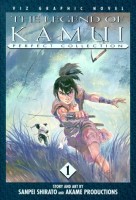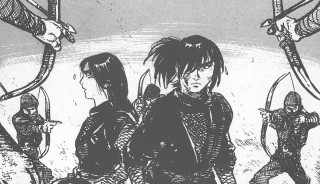 Creator: Sanpei Shirato
Creator: Sanpei Shirato
U.S. publisher: Viz Media
ISBN: 9781569313183
Released: August 1998
Original release: 1990
Sanpei Shirato’s The Legend of Kamui had its beginnings in 1964 as one of the first series to be published in the influential alternative manga magazine Garo. In the 1980s, Sanpei would continue the manga with a second series, Kamui Gaiden. It was Kamui Gaiden that became one of the earliest manga series to be translated into English and widely published in North America. Between 1987 and 1988, Viz and Eclipse Comics released thirty-seven issues of Kamui Gaiden under the title of The Legend of Kamui, serializing edited versions of two stories: “The Island of Sugaru” and “The Sword Wind.” “The Island of Sugaru,” which was later compiled by Viz into two volumes in 1998, is probably one of the most well-known Kamui stories, and not just because of the Kamui Gaiden live-action film adaptation from 2009. The Legend of Kamui, Volume 1 collects the first half of “The Island of Sugaru,” material from a volume of Kamui Gaiden that was originally published in Japan in 1990.
Kamui is an apostate ninja during Japan’s Edo period, on the run from the members of his clan who consider him to be a traitor when he tries to leave. While traveling through Yumigahama he encounters a woman who, like him, once belonged to a clan of ninja. Sugaru has been able to avoid capture and death long enough to establish a new life with a husband and three children who love her, but she is still being hunted and must be constantly vigilant. Sugaru has managed to survive because she doesn’t trust anyone, and that includes Kamui. Although he helped to save her life when she was attacked by Iga ninja, Sugaru can’t take a chance that Kamui might be trying to kill her as well. After an intense battle in which they are both injured, they part ways. But in a strange twist of fate, Kamui is later shipwrecked on the very island where Sugaru and her family reside. Kamui lives peacefully for a time in the small, remote fishing village and Sugaru’s family becomes very fond of him, but Sugaru would rather see him dead.
 From reading The Legend of Kamui, Volume 1 alone, not much is known about either Sugaru or Kamui’s past lives beyond the fact that they are trying to escape them. The hunted versus the hunter, whether the prey chooses to flee or to fight, is a theme that recurs throughout the manga, mirrored in both nature and human society. Kamui and Sugaru do have the advantage of being exceptionally adept fighters. Although Sugaru does strain under the burden of keeping both herself and her family safe, she is actually one of the strongest characters in The Legend of Kamui, Volume 1, exhibiting both great determination and martial prowess. Her skills rival and in some cases surpass those held by Kamui. Tragically, and understandably, due to her circumstances Sugaru has lost her ability to trust others; it’s simply no longer an option for her. Kamui, on the other hand, has so far managed to retain that part of his humanity, even though it has put his life in danger on multiple occasions.
From reading The Legend of Kamui, Volume 1 alone, not much is known about either Sugaru or Kamui’s past lives beyond the fact that they are trying to escape them. The hunted versus the hunter, whether the prey chooses to flee or to fight, is a theme that recurs throughout the manga, mirrored in both nature and human society. Kamui and Sugaru do have the advantage of being exceptionally adept fighters. Although Sugaru does strain under the burden of keeping both herself and her family safe, she is actually one of the strongest characters in The Legend of Kamui, Volume 1, exhibiting both great determination and martial prowess. Her skills rival and in some cases surpass those held by Kamui. Tragically, and understandably, due to her circumstances Sugaru has lost her ability to trust others; it’s simply no longer an option for her. Kamui, on the other hand, has so far managed to retain that part of his humanity, even though it has put his life in danger on multiple occasions.
I really wish more of The Legend of Kamui had been released in English because the series is excellent. The characters are complex, as are their personal struggles and their searches for freedom in an era that could be unforgiving, harsh, and violent. The action sequences are exciting and dynamic. Although a few ninja tricks are employed during the life-or-death battles—secret techniques, impressive acrobatics, illusions and transformations—there is a sense of realism that pervades The Legend of Kamui. In between the dramatic conflicts are the quieter moments of everyday life in a fishing village. Initially it appears as though Kamui, like Sugaru, will be able to outrun his fate and have a chance at a peaceful, happy existence. He learns to fish and becomes friendly with the villagers who are more than happy to welcome a strong young man into their midst. The Legend of Kamui, Volume 1 offers hope that such changes are possible, but ultimately taking charge of one’s own destiny is a difficult path to follow.

Haven’t read this but just from that little snippet of art it looks similar to the art in Path of The Assassin.
Somewhat surprisingly, I haven’t actually read any of Path of the Assassin! But if it’s like Goseki Kojima’s work in Lone Wolf & Cub, then it is a very apt comparison. I think Shirato’s action sequences might be a little more fluid, though that might just be because the styles of fighting in the two series are different.
Funny enough I read POTA but not Lone Wolf & Cub. There was a fair bit of ninja stuff going on but from memory much more sexy stuff. Lovely art.
I sometimes wonder if more older translated manga would sell. POTA and Samurai Executioner and Lady Snowblood all got released by Dark Horse but thats probably due to the name power of the writer of Lone Wolf.
I’m always hoping for more older manga (specifically non-Tezuka manga) to be translated; sadly, it seems less and less likely to ever happen unless there has been a recent re-release in Japan.
I think you’re probably right about the name power of Kazuo Koike. Dark Horse had another series in a similar vein that I loved— Hiroshi Hirata’s Satsuma Gishiden—but only the first half was ever released.